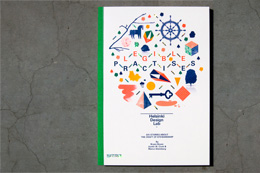As Bryan has already noted, a month ago I left Sitra, left Helsinki and moved to Italy, where I’m the now the CEO of Fabrica, a communications research centre and trandisciplinary studio. (You can read about that here.) Back in Helsinki for the weekend, having left a lush autumnal Veneto on Thursday, I’m posting this from a city that is now −5 and deep under snow.
I leave with mixed feelings: I could not be more excited about the new role at Fabrica, and equally I’m very proud of the projects that we created or developed here—Brickstarter, Open Kitchen, Design Exchange, Low2No and Helsinki Design Lab—and yet, as well as missing Helsinki, I also feel a loss that I’m not able to help take those projects forward.
This last aspect is clearly not important to anyone else, though; what is important are that the projects do have lots of life left within them, numerous unexplored avenues, and that they are taken forward in different contexts, tested under different conditions, by people more than capable of doing so. And that includes you, reader.
For instance, we often get emails asking us if Brickstarter is launching near them; we reply that they can take it! All Brickstarter is, essentially, is a tool to crack open discussions with government, and in public, constructed by taking the existing tropes of social media and crowdfunding and throwing them at spaces, communities and governance. It’s a sketch, and as such can be reinterpreted by others. There is no unique IP there as such—Sitra is a public body—and our “legible practice” approach is intended to enable you to take what we produce and deploy it elsewhere. Equally, there is no particular magic there. Again, it’s taking off-the-shelf cultural artefacts—social media—and deploying them in a slightly different context to their usual mise-en-scene.
The issue is in how you do it, who is doing it. That is what holds governments back usually, as there is barely a government, at city or state level, anywhere in the world who has the right people in the right place. In the particular case of Brickstarter, that means coders, designers, community managers, organisational entrepreneurs in strategic positions at the heart of government. Those things are usually treated as services to be bought in from outside and frankly, by people who don’t know what they’re buying.
However, there are a few honourable exceptions to this emerging, which is very encouraging. Those people have no need of Brickstarter and Open Kitchen, as they will already have a hunch as to what to do and how to do it. That could be you.
We’ve been so open and precise about the development of Brickstarter that it has often confused. Again, it is a sketch, and a conversation. To make that meaningful, we had to detail everything, to think it out loud, as it were. Thus, people thought it was a real live service—some people who can only see things through the lens of “hot new startups” and then wondered as to why we were blogging about other urban crowdfunding services (“Were those not competitors?”)
No, it was research, and designing a real(ish) website was also research, but research that is intended to affect. As we’ve written elsewhere, only by making do you genuinely influence—as it forces you to make meaningful decisions, as well as making abstract concepts tangible and legible —and I hope we made just enough to help bend the debate in a productive direction, just a notch. One of our core points to get across is that the ability to design a convincing looking website relatively rapidly, as well as a clickable prototype front-end, is not confined to Californian start-ups. In fact, it’s perfectly possible to pull it off in a relatively slow-moving, relatively bureaucratic public body in a welfare state. (The UK’s Government Digital Service is doing this for real, of course.)
We often quote Joi Ito, as a) he’s very smart, and b) so damn quotable! But here I might quote his predecessor at MIT, Nicholas Negroponte in Wired UK last month, found in a great piece about Ito.
“Start-ups are perforce small—you’ve got to focus, the blinders get narrower. By definition it’s not big thinking.”
I find that an interesting, subtle critique, and in getting Sitra, an institution—in an age when institutions are permanently under the cosh—to borrow a little from start-up culture without losing its institutional status and capacity, we might actually shoot for an interesting space in the middle, something other than the hegemonic start-up, if I read between Negroponte’s lines. With the ability to move quickly and prototype, yet retaining “big thinking”, systemic change.
Anyway. This approach to legibility—to thinking out loud through communicable means, in public—means that we can at least move on, and the projects live on. Brickstarter, in appearing in Steven Johnson’s latest amongst numerous other places, has already help move the conversation on in practical terms, we think. And I’ll continue the themes we started here in my new role at Fabrica, just as the others will too.
Watch out also for Open Kitchen, which we’ve published less about, mainly due to the fact that this is more of a real partnership. But if Brickstarter is largely applied research and discussion starter, trying to affect a culture, Open Kitchen is real live service deployed into the real live city, also trying to nudge the city's food culture forward. Watching the videos of the applicants to Open Kitchen was actually rather moving—that feeling you get when a hunch becomes a project, and then people adopt that project with gusto, and fill it with their own lives, enthusiasms, energy and spirit.
Open Kitchen is running now, and I’m sure it will be reported on thoroughly here and elsewhere. But that too is a project I’m proud of, which has filled much of the last year. It’s been hugely rewarding to move a project that started as a food truck concept for Low2No, via research, writing, teaching, drawing and self-publishing, into some kind of “HEL YES’s Kitchen”, a food start-up incubator running in the renovated abbatoir in Kalasatama, and subtly aimed at building a new user-centred interface onto the City of Helsinki. Many thanks to Ville Relander from City of Helsinki, Antto Melasniemi and Elina Forss, for this one. It’s been a blast.
The broader strategic design practice will move forward too. When we held HDL 2012 a couple of months ago, we were lucky enough to bring together a group of people to unpack various approaches to strategic design. It was heartening to see the emerging community around this work; although the work is still at the edges, it’s building momentum and a faint network of lines is being traced across the map.
For instance, on hearing my news Justin McGuirk remarked to me that it was a shame he can no longer say, “At least the Finns get it!” (Justin had written about our work a couple of times in The Guardian.) I told him that he still can say that, but also that he can also say the Danes get it (at Mindlab), the Americans get it (via IDEO, Brownsville Partnership, Local Projects and others), the Chileans get it (via Elemental, Tironi et al), the Brits are beginning to get it (at Nesta, Government Digital Services and elsewhere) and the Canadians and the Australians are now getting it too, with similar operations emerging in those very different corners of the globe. We’ve sometimes helped shape them a little, based on our Finnish experience and through hosting the network occasionally, just as others have, but most of this—and in particular the hard graft of getting it done in their particular cultures—is all their own work. That is also heartening.
All these—and more we don’t know about—are deploying design in new ways, in various modes and alongside other approaches, to help shape public decision-making and rethink more resilient public sectors. I think the work we’ve done here has helped push this mission along, and I’m proud of what we got done in my couple of years here, as a small part of the longer project by my colleagues, which still continues.
Huge thanks to the team—Anna, Bryan, Justin and Marco, and our great interns Kalle and Maija—as well as those other teams at Sitra I’ve worked with, and all our external partners—hello Antto, Elina and various Villes!, and the various ministries and government departments on Design Exchange, partners on Low2No—as well as our supporters in Helsinki and elsewhere.
Kiitos, moi moi.




is this for good or evil?
posted by 2ambitious — 4 weeks ago